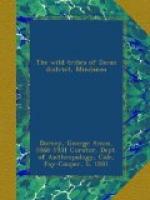“The greatest of all the spirits is Manama[1] who made the first men from blades of grass, weaving them together until they resembled a human form. In this manner he made eight persons—male and female—who later became the ancestors of the Ata and all the neighboring tribes. Long after this the water covered the whole earth and all the Ata were drowned except two men and a woman. The waters carried them far away and they would have perished had not a large eagle come to their aid. This bird offered to carry them to their homes on its back. One man refused, but the other two accepted its help and returned to Mapula.
[1] See page 106.
“The other deities are Mandarangan, Malalayug,
god of agriculture;
Mabalian, the spirit who presides over childbirth;
Tarasyub and
Taratuan, the guardian spirits of the brass and iron
workers;
Boypandi—the spirit who guards over the
weavers.”
While in the Ata country the Governor observed certain customs of the people. As his party approached the palisaded house of Madundun they stopped for twenty minutes to perform a ceremony called anting-anting. “An old man waved his shield and a cloth, meanwhile repeating mysterious words. Then each man was given a chew of betel-nut and was well rubbed with a charm.” “At Tuli a swarm of bees passed over the house just as the party was ready to start. This was taken as a sign that some of the party would be killed by the arrows of the enemy, hence they refused to go.” “Likewise, if the dove limokan calls on the left side of the trail the party will refuse to proceed, unless another limokan answers the call from the right side of the path.”
VI. MANDAYA.
("Inhabitants of the Uplands").
SYNONYMS.
(a) MANSAKA ("Inhabitants of the mountain clearings"). This name is applied to those Mandaya who formerly dwelt far back in the mountains. Many of this division have recently emigrated to the coast and are now found at the north and east part of Davao Gulf.
(b) PAGSUPAN. The appellation by which the members of this tribe, living near the Tagum and Hijo rivers, are known.
(c) MANGWANGA or MANGRANGAN ("Dwellers in the forests"). A name by which are designated those Mandaya who live in the heavily forested mountains skirting the coast.
(d) MANAGOSAN or MAGOSAN. The members of the tribe living on the headwaters of the Agusan river bear this name.
(e) DIVAVAOAN. A division which inhabits a small district to the south and west of Compostela. Very little is known of this people, but from the information now at hand it seems that they should be classed as a branch of the Mandaya.
HABITAT.
This tribe occupies both slopes of the mountain range which borders the Pacific ocean, from about 9 degrees of North latitude south nearly to Cape San Agustin. Its members are also found in considerable numbers from the head of the Agusan drainage nearly to the town of Compostela, and several settlements of this people are to be found along the Hijo and Tagum rivers, while in recent years a number have established themselves on the eastern side of Davao Gulf.




